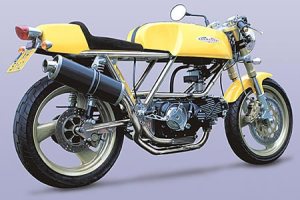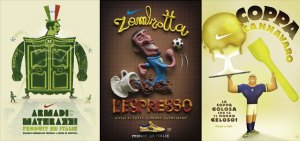Thursday, October 22, 2009
Ferrari's Lasting Impact On Creative Humans
Prepare to be amazed.
The power of Ferrari to inspire comes in many ways does it not?
The University Of Gastronomic Sciences In Pollenzo
 Founded in 2004, the University of Gastronomic Sciences (PDF file here) brings a scientific approach to food. Italians really do have the philosophy of food down to a science and have class books to .
Founded in 2004, the University of Gastronomic Sciences (PDF file here) brings a scientific approach to food. Italians really do have the philosophy of food down to a science and have class books to .You can read more about this interesting school - which I hope to sign up for one day in the future - in this piece from The New York Times.
GermItalia
 I've always detected an interesting attraction and affinity held between Italy and Germany: two great artistic societies who found ways to transfer their craftsmanship into modern industrial design. It's a strange cultural partnership indeed but one that is defined and bound by history. I'll let Man of Roma take it from here with two posts: Pleasure in Craft. The Germans and Roman Limes. Between Two Worlds.
I've always detected an interesting attraction and affinity held between Italy and Germany: two great artistic societies who found ways to transfer their craftsmanship into modern industrial design. It's a strange cultural partnership indeed but one that is defined and bound by history. I'll let Man of Roma take it from here with two posts: Pleasure in Craft. The Germans and Roman Limes. Between Two Worlds.
From Air Design To Creating Motorcycles
 Owned by Finmeccanica, Alenia Aermacchi (originally Aeronautica Macchi) was founded in 1912 and a manufacturer of seaplanes in its early days, is a world leader in the military trainer aircraft market.
Owned by Finmeccanica, Alenia Aermacchi (originally Aeronautica Macchi) was founded in 1912 and a manufacturer of seaplanes in its early days, is a world leader in the military trainer aircraft market.Like so many of Italy's companies, Aermacchi has a deep, rich history that demands some attention. After World War II, the company joined the lucrative motorcycle industry and selected a designer named Lino Toni from Benelli to lead it in that direction.
Aermacchi had an extremely successful and influential run in the motorcycle world and were eventually bought and sold by Harley-Davidson.
The factory was sold to a pair of brothers who eventually started another great motorcycle company: Cagiva.

For their parts, Benelli and Cagiva were originally engaged in firearms and small metal components - but that's for another post.
Neo-Vintage Posters
Another Face of Italian Genius
Accenti Magazine, Summer 2006.
A few years ago, I was sharing an espresso with a local restaurateur. The subject of our discussion was his ten thousand-dollar coffee machine from Italy. Curiously, the direction of the conversation brought us to a side of Italy rarely talked about - its industrial face.
Words like industry are not normally associated with how we perceive Italy. Indeed, to offer a bold statement, by some estimates 60 per cent of the Western world's treasures are to be found within Italy's borders. Another estimate claims that Italy exports 45 per cent of the world's luxury items. These are astounding figures. Then again, to anybody who has been to Italy, these figures are not surprising.
 This 'geographic expression', as it was once called, is essentially one giant museum of fine living. By now, many of us are familiar with much of what Italy is famous for - from the fine arts of film, fashion, architecture and music to its highly regarded and world renowned culinary heritage with espresso, wine, cheese and gelato. Their sports culture, littered with international successes, should not be underestimated either.
This 'geographic expression', as it was once called, is essentially one giant museum of fine living. By now, many of us are familiar with much of what Italy is famous for - from the fine arts of film, fashion, architecture and music to its highly regarded and world renowned culinary heritage with espresso, wine, cheese and gelato. Their sports culture, littered with international successes, should not be underestimated either.However, their industrial accomplishments do not get as much attention: The artful ability to create works of art from cold, uninspiring elements of the post-industrial age - metal and steel. Italy is not only a purveyor of 'la dolce vita' or the finer, sweeter things in life, but is equally an innovator in the harder, sharper elements of it.
Italy brought its industrial and manufacturing base to new heights during the 20th century. By applying creative and elegant design to industrial machinery - like the coffee machine that sparked this article for example - mainly in the cities of Torino and Milano, Italy quickly distinguished itself in the post-war years as a dominant global trendsetter in industrial and manufacturing design.
Today, Italy ranks 7th in the world in industrial and manufacturing output. It is a nation that conceives performance in both man and machine. The Futurist Art movement is a marvelous example of this.
For those bemoaning today's global, mechanized cookie-cutter approach to manufacturing, look no farther than Italy; it is home to hundreds, if not thousands of companies, family dynasties and small shops devoted to the craftsmanship of the forgotten art of small details.
Metal? Steel? These are not things we usually associate with Italy. When we think about Italy it immediately conjures up romantic and picturesque images of Capri or world class ski resorts. Steel, and its efficient application of it, normally brings to mind other economic powers like Germany, Britain, France, Japan and the United States. Italy? Really?
Really. It is a side of Italy I personally never paid close attention to and was slow to realize. Buoyed by innovative and avant-garde engineers that perfected Italian industrial design, some of the most famous names in Italy are manufacturing legends. They include Piaggio (makers of the iconic Vespa scooters) in airplane building, Beretta in fine pistol manufacturing, Ducati and Aprilia (owned by Piaggio) in motorcycling and Campagnolo, Bianchi and Columbus Steel in bicycle manufacturing.
Of course, high performance sports cars are synonymous with Italy's fascination with speed. Needless to say, Italy has earned a racy reputation with the likes of Alfa Romero, Maserati and Ferrari to name a few manufacturers.
Design does not begin and end with form in Italy. In car manufacturing, for example, it includes all the tiny pieces of metal that create the whole machine-cranks and blocks, hydraulic lifters, cam shafts, bearing caps, breaks and gear boxes and countless other pieces. These are definitely not your run-of-the-mill machine-shop components that make a car go- they are works of high quality art that complement the design geniuses of Pininfarina, Zagato and Michelotti.
Nor does it end with moveable objects with an engine. One would think that manufacturing bicycles does not demand technical innovation, but do not tell that to cycling-mad Italy. Primary materials in aerodynamic bicycle manufacturing include carbon fibre, titanium, exotic steel and aluminum alloys.
Lastly, in the land where the Etruscans, Romans and Renaissance Humanists were born, Italy was among the first European nations to offer their engineering know-how in space exploration through the Italian Space Agency. Together with NASA, the Italian Space Agency takes part in various development projects. The ultimate recognition of Italy's presence in the post-industrial age.
After enjoying a fine Italian lunch, when asked what sets Italians apart from most cultures, the French-Canadian restaurateur I was sharing an afternoon with told me in this casual but intriguing conversation, that Italians do not just make espresso. They make the machine to perfect it. They also make the knives and metalwork to cut their culinary creations and they produce the machines to perfect the shoe. They are, in today's global economy, fully integrated artists.
An appropriate analogy would be in film. A director's artistic vision imprints his or her distinctive style on the story. The great Italian director, Federico Fellini, left his fingerprint on every film he made that broke with classical styles during that period. In a way, Italy's great industrial designers have left a legacy reminiscent of Fellini. In this light, perhaps those figures mentioned and their achievements on the onset are not that surprising.
Boxing: Nino Benvenuti

I came across this image while reading up on some boxing. I remember reading in Sports Illustrated (way back in the 1980s) about the tradition of great Italian and Italian-American boxers. Benvenuti is widely regarded as the greatest Italian boxer ever. His accomplishments include a Gold medal at the 1960 Olympics in Rome, World Light Middle-Weight champion (1965-1966), World Middle-Weight Champion (1967, 1968-1970).
Italy's Secrets of Innovation

From the website:
"MegaWorld: Italy explores cutting-edge innovations revolutionizing the fields of aerospace engineering, automobile design and urban planning. Hosted by Kevin Brauch (da Vinci: Unlocking the Genius, Thirsty Traveller), this fascinating one-hour special takes a closer look at how the teams behind Italian automobiles, aircraft and military equipment are influencing the trajectory of technology across the world.
From the techniques used to perfect the sleekest sports cars on the road to the initiatives developed to keep Venice above water, MegaWorld: Italy reveals the ground-breaking strides scientists, engineers, inventors and designers are making in their respective fields. Join these experts as they reveal the secrets behind Italy's latest achievements. Then, step inside the state-of-the-art facilities where leading experts reveal how Italy's coolest and fastest exports are developed, manufactured and tested for use."
A presto.
Photo: Pininfarina wind tunnel.
Exploring the Concept of the "Italian Style"
The book is 231 pages and within its content explores the social conditions that helped form and shape the Italian industrial and artistic mind in the 20th century.
Wednesday, October 21, 2009
Campagnolo: Optimum Artechnology
 Established in Vicenza in 1933 by Commendatore Tullio Campagnolo, the storied Campagnolo company is considered to be the most prestigious standard in hand crafted, high-performance bicycle racing components. Along the way, Campagnolo has distinguished itself by providing the cycling world with innovations and ideas that has revolutionized the sport.
Established in Vicenza in 1933 by Commendatore Tullio Campagnolo, the storied Campagnolo company is considered to be the most prestigious standard in hand crafted, high-performance bicycle racing components. Along the way, Campagnolo has distinguished itself by providing the cycling world with innovations and ideas that has revolutionized the sport.Three fundamental concepts have come to characterise the company: "performance, technological innovation, and quality of products and services."
Campagnolo's expertise is not restricted to bicycles. It has expanded into other areas including manufacturing and building superlight magnesium wheels for cars (including Maserati and Alfa Romero) and satellite chassis for NASA.
The utilization (and perfection) of prime-quality materials such as carbon fibre, titanium and aluminium alloys has set Campagnolo apart. From its website, " And it is precisely in the carbon-fibre sector that Campagnolo, after dominating the aluminium world for decades, has now decided to make a name for itself with applications that were previously deemed unthinkable for the cycling market. It therefore comes as no surprise that the Composites Department, launched in 1998, currently employs one third of Campagnolo’s employees. Products in carbon fibre are constantly being created as a glance at the 2008 collection reveals: cranksets, front and rear derailleurs, integrated controls, headsets, seatposts, bottle cages and high and low-profile wheels all made from carbon fibre."
For a list of Campagnolo milestones including the "quick release" concept, derailleurs and Ergopower gear systems please follow the link to its official website.
In the 21st century, Campagnolo retains its unique Italian character in a highly competitive globalized world.



